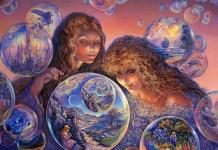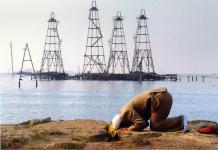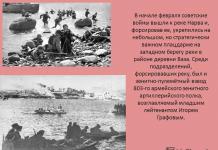Baroque sculpture is an artistic style in the field of sculpture. It emerged in the 17th – first half of the 18th centuries, as one of the components of the Baroque era in culture. Characterized by: - emphasized theatricalization of images - dynamism of poses - expressiveness of faces and gestures - specific extravagance of Lorenzo Bernini. David

The first innovation introduced by Baroque sculpture was an interest in the dramatic complexity and diversity of the world. The main attention was paid to the dynamism of the ensemble through the implementation of scenes depicting a specific moment of some action. The sculptors sought to include the audience in the space of the sculpture and enhance the spectacle of the scene. Sculpture, like painting and architecture, served the monarchy, the church and the bourgeoisie. Francois Girardon. Apollo and Nymphs.

Gian Lorenzo Bernini () Bernini is considered the creator and exponent of the Baroque. His sculpture embodied the main elements of this style: - dynamism of poses, - sharp turn of bodies, - expressiveness of gestures and faces, - polished marble surface, as well as - multiple angles, which allows you to perceive the sculpture from different points of view. Among his best works of the early period are "Apollo and Daphne" () and "David" (1623)

"Saint Longinus" () in St. Peter's Basilica Portrait of Constanza Buonarelli (1635)

Tombstone of Pope Urban VIII () "The Ecstasy of St. Teresa" ()

The last period of the sculptor's creativity () was marked by an increase in spirituality. Among the works of this period, “Blessed Lodovica Albertoni” (1674) stands out.

Mythical French vanity French sculpture of the 17th century. marked the beginning of a decline that only a few authors who emerged in Italy managed to avoid. Jacques Sarrazin, who went through the Italian school, combined classicism and baroque in his work and was ahead of the style of Louis XIV. Statue of Louis XIV in Versailles.

Two sculptors, François Girardon and Antoine Coyzevox, broke with Bernini's legacy. Both worked on the decoration of the Palace of Versailles and were the king's favorite sculptors. Francois Girardon. Round colonnade. Palace of Versailles. Antoine Coyzevox. Vase of War in the park of Versailles.

Francois Girardon. Tombstone of Cardinal Richelieu ().

Expression of religious feeling in Spain In plastic art, a certain duality was established between realism and symbolism: subjects taken from real life were used, but their reading in a religious key was proposed. In form the sculpture was closer to classicism, and in content to baroque. Gregorio Fernandez. Pietà (1617; National Museum of Sculpture, Valladolid).

In Andalusia, all activity was concentrated in the two cities of Seville and Granada, where sculptors emphasized the realism of sacred images, but enhanced their emotionality and spirituality. Pedro Roldano. decoration of the altar in the Cathedral of Seville (). Seville


No matter how they called this style! - Strange, prone to excess, ridiculous, pretentious, unnatural...
At first these characteristics sounded like a joke. And all only because the new style did not correspond to the canons of ancient art, on the basis of which a work of art should be built and which later used classicism and rationalism. That is, only this way and not otherwise.
But, as you know, there is nothing permanent in the world: everything flows, changes and acquires new qualities and priorities. And now the new 17th century was marked by a new style. This style has subjugated all types of art: from interiors and clothing to music. But the time will come - and another style will supplant it...
In which country could Baroque originate? Of course, in Italy. It was Italy that was the center of European culture in the 17th-18th centuries, and from here the triumphant march of the Baroque across Europe began. In each country, Baroque had its own special national features.
Features of the Baroque style
The most important features of Baroque are its desire for pomp and grandeur. Baroque was also characterized by dynamism and contrast, which greatly distinguished it from Renaissance harmony.
If we talk about the era and the people who lived at this time, you can see a special passion for entertainment, card games, it was at this time that masquerades, fireworks, elaborate women's hairstyles, corsets, unnaturally widened skirts on frames, and powdered wigs for men became popular , shaved face, etc. As we see, there is a strong departure from natural life, which was rejected as savagery and unceremoniousness. One has only to remember how much effort Peter I made to “ennoble” Russian society of that time. In the collection “An Honest Mirror of Youth”, prepared on his instructions, its second part is entirely devoted to the rules of behavior for “young youths” and girls of the noble class. In fact, this is the first etiquette textbook in Russia. The young nobleman was recommended to study, first of all, foreign languages, horse riding, dancing and fencing. The girl's virtues were recognized as humility, respect for parents, hard work and silence, and chastity. The essay regulated almost all aspects of public life: from table manners to public service. The book formed a new stereotype of the behavior of a socialite, avoiding bad company, extravagance, drunkenness, rudeness and adhering to European social manners.
Baroque in painting
The same features of the Baroque are also in painting: splendor of forms, catchy dynamism and brightness, originality of subjects. The most famous representatives of this style in painting were Rubens and Caravaggio.
Peter Paul Rubens (1577-1640)
South Dutch (Flemish) painter who embodied the mobility, unbridled vitality and sensuality of European painting of the Baroque era.

P.P. Rubens "Self-Portrait" (1623)
His paintings are distinguished by their exceptional diversity, especially regarding composition: he uses diagonal, ellipse, and spiral. His palette is also varied; the richness of colors is a distinctive feature of his paintings. “Rubensian” women are usually somewhat heavy, but attract attention with their heavy female form.

P.P. Rubens "The Rape of the Daughters of Leucippus" (1618)
The plot of this painting by Rubens is the myth of the brothers Castor and Pollux (sons of Zeus and Leda), who kidnapped the daughters of King Leucippus - Gilaira and Phoebe. In this plot, Rubens was captivated by the dramatic moment of the abduction itself, which provides rich opportunities for plastic solutions. The picture amazingly conveys the dynamics of movement. Movement, as understood by Rubens, carries both an emotional impulse and a plot meaning.
Rubens is considered an innovator in depicting hunting scenes, which are also distinguished by their dynamics, unexpected composition and rich colors.

P.P. Rubens "The Hunt for the Hippopotamus" (1618)
Baroque architecture
Baroque architecture is striking primarily in its complexity and scope. An abundance of complex, usually curvilinear forms, large-scale colonnades. There is an abundance of sculpture on the facades of buildings and in the interiors. Often multi-tiered domes of complex shapes. Endless repetition, duplication of the same techniques.

Cathedral of St. Petra (Vatican)
I. Grabar writes about Roman architecture of the Baroque era: “Neurasthenic enthusiasm doubles and triples all means of expression: there are no longer enough individual columns, and where possible they are replaced by paired ones; One pediment seems insufficiently expressive, and they do not hesitate to tear it apart in order to repeat another, smaller scale. In pursuit of a picturesque play of light, the architect does not reveal all forms to the viewer at once, but presents them gradually, repeating them two, three and five times. The eye gets confused and lost in these intoxicating waves of forms and perceives such a complex system of rising, falling, receding and approaching, now emphasized, now lost lines, that you don’t know which of them is correct? Hence the impression of some kind of movement, continuous running of lines and flow of forms. This principle reaches its highest expression in the technique of “bracing”, in that repeated fragmentation of the entablature, which causes a whimsically curving line of the cornice at the top of the building. This technique was elevated by the Baroque masters into a whole system, unusually complex and complete. This also includes the use of group pilasters, when the pilasters receive additional half-pilasters on the sides, as well as the use of flat frames framing the intervals between the pilasters.” By such means in architecture, instead of the Renaissance ideal of clear, stable and complete harmony, a “ghostly sensation” was created.

Distinctive Baroque details -Atlanta(telamones), caryatids– to support vaults, playing the role of columns;mascarons(a type of sculptural decoration of a building in the shape of a human or animal head from the front).


Perhaps it is in architecture that the Baroque is presented in all its fullness and diversity. It’s difficult to even list all the architects of this style; let’s name just a few names: L. Bernini, F. Borromini in Italy, B. F. Rastrelli in Russia, Jan Christoph Glaubitz in Poland.
In Italian architecture, the most famous representative of the Baroque was Carlo Maderna (1556-1629). His main creation is the facade of the Roman church of Santa Susanna (1603).

Santa Susanna (Rome)
The sculptor Lorenzo Bernini was also an architect. He is responsible for the design of the square of the Cathedral of St. Peter's in Rome and interiors, as well as other buildings.

Square of the Cathedral of St. Peter's in Rome
The Baroque style is becoming widespread in Spain, Germany, Belgium (Flanders), the Netherlands, Russia, France, and the Polish-Lithuanian Commonwealth (Poland). At the beginning of the 18th century. France had its own style, a variety of Baroque - Rococo. It predominated not in the external design of buildings, but only in the interiors, as well as in the design of books, clothing, furniture, and paintings. The style was widespread throughout Europe and Russia. But we'll talk about it later. Now let's focus on Russian Baroque.
Baroque in Russia
Baroque appeared in Russia at the end of the 17th century. (it was called “Naryshkin baroque”, “Golitsyn baroque”). During the reign of Peter I, the so-called “Petrine baroque” (more restrained) began to develop in St. Petersburg and its suburbs in the works of D. Trezzini; it reached its peak during the reign of Elizabeth Petrovna in the works of S. I. Chevakinsky and B. Rastrelli.
Peter's Baroque
This term is used by art historians to describe the artistic style approved by Peter I and widely used to design buildings in the new Russian capital of St. Petersburg.
It was an architectural style based on examples of Swedish, German and Dutch civil architecture. Although it is possible to reduce the entire variety of architectural solutions of Peter the Great’s architects to Baroque only with a certain degree of convention, because There are features of classicism and gothic here.
The architecture of Peter the Great's time is characterized by simplicity of volumetric constructions, clarity of divisions and restraint of decoration, and a planar interpretation of facades. Unlike the Naryshkin Baroque, popular at the time in Moscow, Peter the Great's Baroque represented a decisive break with the Byzantine traditions that had dominated Russian architecture for almost 700 years. Golitsyn Baroque was similar to Italian and Austrian examples.
Among the first builders of St. Petersburg are Jean-Baptiste Leblon, Domenico Trezzini, Andreas Schlüter, J. M. Fontana, Nicolo Michetti and G. Mattarnovi. All of them arrived in Russia at the invitation of Peter I. Each of these architects introduced the traditions of their country and the architectural school that they represented into the appearance of the buildings they constructed. While supervising the implementation of their projects, Russian architects, such as Mikhail Zemtsov, also adopted the traditions of European Baroque.
Peter's Assemblies

They were the prototype of a noble ball. Peter I introduced assemblies into the cultural life of Russian society in December 1718.
The idea was borrowed by Peter from the forms of leisure that he saw in Europe. They were held at all times of the year, in the summer – outdoors. The assemblies included food, drinks, dancing, games and conversation. According to the decree, attendance at the assemblies was mandatory not only for nobles, but also for their wives, which was closely monitored by the “king of balls” Yaguzhinsky. Yesterday's boyars tried in every possible way to avoid participating in assemblies, not wanting to dress in the new fashion and considering such a pastime indecent. The participation of women in entertainment also caused dissatisfaction. To prevent “absenteeism,” Yaguzhinsky looked through the lists of those invited to the assemblies and identified “netchikov.” This is how hard it was for European fashion (in this case, the Baroque style) to take root in Russia.
Domenico Trezzini (1670-1734)

Italian, born in Switzerland. From 1703 he worked in Russia, becoming the first architect of St. Petersburg. Trezzini laid the foundations of the European school in Russian architecture.

Peter and Paul Cathedral is one of the most famous works of Domenico Trezzini
His other works:
Project of the Alexander Nevsky Lavra complex (1715)
Anichkov Bridge (1721). Rebuilt to increase the crossing capacity. The new project is an 18-span wooden bridge with a drawbridge in the middle. The construction was carried out by the Dutch master H. van Bolos.

Anichkov Bridge (modern view)
Peter and Paul Cathedral (1712-1733) Erected on the site of a wooden church of the same name. The bell tower spire with the figure of a flying angel was erected by the Dutch master H. van Bolos.
House of Trezzini (1721-1726). The design was carried out by Trezzini himself, the construction was carried out by M. Zemtsov.
Expansion of the Winter Palace of Peter I for Catherine I (1726-1727)
Bartolomeo Francesco Rastrelli (1700-1771)

OK. Pfandzelt "Portrait of Rastrelli"
Russian architect of Italian origin, academician of architecture at the Imperial Academy of Arts. The most prominent representative of the so-called Elizabethan Baroque.
His works:

Rundāle Palace (Latvia). Built in the Baroque style according to the design of F. B. Rastrelli for E. I. Biron in 1736-1740).
Mitava Palace (Latvia). Built in the 18th century. designed by Bartolomeo Rastrelli as the ceremonial city residence of the Dukes of Courland and Semigallia in their capital Mitava (now Jelgava).
Grand Palace (Peterhof). Located on the southern shore of the Gulf of Finland.

St. Andrew's Church (Kyiv). Orthodox church in honor of the Apostle Andrew the First-Called; built in the Baroque style according to the design of Bartolomeo Rastrelli in 1754.
Smolny Cathedral (1748-1764), Vorontsov Palace (1749-1757), Great Catherine Palace (1752-1756) - all in St. Petersburg; "Grotto" pavilion in Tsarskoe Selo (1753-1757), "Hermitage" pavilion in Tsarskoe Selo (1744-1754), Tsar's Palace in Kyiv (1752-1770), Stroganov Palace and Winter Palace in St. Petersburg (1753-1762) .

Winter Palace (Hermitage)
Only the surviving buildings of this architect are listed. Unfortunately, not everything created by Rastrelli has survived to this day.
Baroque in sculpture
The greatest sculptor and recognized architect of the 17th century. was the Italian Lorenzo Bernini.
Giovanni Lorenzo Bernini (1598-1680)

D.L. Bernini "Self-Portrait"
His most famous sculptures are the mythological scenes of the abduction of Proserpina by the god of the underworld Pluto and the miraculous transformation of the nymph Daphne into a tree, pursued by the god of light Apollo, as well as the altar group “The Ecstasy of Saint Teresa” in one of the Roman churches. This sculpture, with clouds carved from marble and the characters' clothes fluttering in the wind, with theatrically exaggerated feelings, very accurately expresses the position of the sculptors of this era.

D.L. Bernini "The Rape of Proserpina" (1621-1622). Borghese Gallery

D.L. Bernini "Ecstasy of Saint Teresa"
Baroque literature
In Baroque literature, writers and poets developed a tendency to perceive the real world as an illusion or a dream. Allegorical images, symbols, metaphors, theatrical techniques, antitheses, and rhetorical figures were often used. There is a noticeable desire for the symbolism of the night, the theme of frailty and impermanence, life as a dream. One of P. Calderon’s plays is called: “Life is a Dream.” The action of the novels is often transferred to the fictional world of antiquity, to Greece, court gentlemen and ladies are depicted as shepherdesses and shepherdesses, which is called pastorals. In poetry there is pretentiousness, the use of complex metaphors. The sonnet, rondo, concetti (a short poem expressing some witty thought), and madrigals (a love-lyrical musical and poetic work) are common.
In Russia, Baroque literature includes S. Polotsky and F. Prokopovich.
Simeon of Polotsk (in the world Samuil Gavrilovich Petrovsky-Sitnyanovich, 1629-1680)

Worker of East Slavic culture, spiritual writer, theologian, poet, playwright, translator, Basilian monk, court astrologer. He was a mentor to the children of the Russian Tsar Alexei Mikhailovich: Alexei, Sophia and Fedor.
He was also one of the first Russian poets, the author of syllabic verses in Church Slavonic and Polish. In addition to the poetic transcription of the Psalter called “The Rhyming Psalter,” Polotsky wrote many poems that made up the collection “Rhythmologion,” in which he sang various events from the life of the royal family and courtiers, as well as many moral and didactic poems included in “Vertograd the Multicolored.” This collection is the pinnacle of the work of Simeon of Polotsk, as well as one of the most striking manifestations of Russian literary baroque.
S. Polotsky also wrote two comedies (school dramas) for the nascent theater; “The Comedy of the Parable of the Prodigal Son” enjoyed particular success.
Baroque music
Baroque music appeared at the end of the Renaissance and preceded the music of classicism. Pretentious forms, complexity, pomp and dynamics were also characteristic of music. But many works of the Baroque period have become classics and are still performed today: fugues by Johann Sebastian Bach, works by George Frideric Handel, “The Seasons” by Antonio Vivaldi, “Vespers” by Claudio Monteverdi.

E.G. Haussmann (Hausmann) “Portrait of J. S. Bach”
Baroque music is characterized by musical ornamentation, which in the heyday of the style became very sophisticated, and methods of playing instruments developed. The scope of genres has expanded, and the complexity of performing musical works has increased. Appeared in the Baroque era opera. Many Baroque musical terms are still used today.

F.M. de La Cava "Portrait of A. Vivaldi"
Baroque fashion
The fashion of the Baroque era corresponds in France to the period of the reign of Louis XIV, the second half of the 17th century. It was a time of absolutism. Strict etiquette and complex ceremonies reigned at court. The costume was subject to etiquette. It was France that was the trendsetter in Europe, so other countries quickly adopted French fashion: a general fashion was established in Europe, and national characteristics were preserved only in folk peasant costume. Before Peter I, European costumes were almost never worn in Russia.
The costume was distinguished by its primness, pomp, and abundance of decorations. The ideal man was Louis XIV, the “Sun King,” a skilled horseman, dancer, and marksman. He was short, so he wore high heels.

N. de Largilliere “Portrait of Louis XIV with his family”
Since Louis was crowned at the age of 5, short jackets (brassieres), decorated with lace, and pants (rengraves), similar to a skirt, also richly decorated with lace, came into fashion. Justocor is a type of caftan, knee-length, worn buttoned, with a belt over it. A sleeveless camisole was worn under the caftan. The caftan and camisole will turn into a jacket and vest in 200 years. The collar of the justocor was at first turned-down, with semicircular ends extended downward, and later it was replaced by a frill. In addition to lace, there were many bows on the clothes. Before Louis XIII, boots (over the knee boots) were popular. They even wore boots at balls. They continued to be worn under Louis XIV, but only on military campaigns. In a civilian setting, shoes came first. Until 1670 they were decorated with buckles and then with bows. Elaborately decorated buckles were called agraf.
Men wore fluffy wigs that stuck high and flowed over their shoulders. Wigs came into use under Louis XIII, who was bald. Later they became much more magnificent. Hats in the 1660s were wide-brimmed with a high crown. At the end of the century they were replaced by a cocked hat, which remained popular in the 18th century.

Baroque in clothes
The woman's dress was lined with whalebone. It gradually expanded towards the bottom, and a train was worn at the back. A full women's costume consisted of two skirts: the lower (fripon, light) and the upper (modest, darker). The underskirt was visible, the upper skirt diverged to the sides from the bottom of the bodice. The sides of the skirt were decorated with draperies. There were also drapes along the edge of the neckline. The waist was narrow; a corset was worn under the dress.
In the 1660s, Mancini and Sevigne hairstyles were fashionable, and later the fontange hairstyle came into fashion. This is a high hairstyle with many curls.

Umbrellas came into fashion, and for women, muffs and fans. Cosmetics were used without measure: all kinds of spots were sculpted on the face (the black spot created a contrast with the powdered faces and wigs). Men and women carried canes.
Popular materials of that time were wool, velvet, satin, brocade, taffeta, moiré, camelot, and cotton.
Baroque in the interior
It is characterized by ostentatious luxury. Wall painting has become widespread, although it was popular earlier.

Baroque interior
The interiors used a lot of color and large, richly decorated details: frescoed ceilings, marble walls, gilding. Color contrasts were typical, for example, a marble floor decorated with tiles in a checkerboard pattern. Extensive gilded decorations are also a characteristic feature of the Baroque.
Furniture was a piece of art and was intended to decorate the interior. Chairs, sofas and armchairs were upholstered in expensive fabric. Huge beds with canopies and flowing bedspreads and giant wardrobes were widespread.

The mirrors were decorated with sculptures and stucco with floral patterns. Southern walnut and Ceylon ebony were often used as furniture materials.
The Baroque style is only suitable for large rooms, since massive furniture and decorations take up a large amount of space. By the way, there is already a tendency towards its return - some are furnishing their apartments in this style.
Most characteristic features Italian architecture of the 17th century embodied in the monuments of Rome. It was here that the main feature of the Baroque was most clearly manifested - the desire to create an ensemble. “This style united buildings from different eras into an architectural whole. In Roman Baroque architecture, new types of temple, city square and palace ensemble appeared.
The first example of the Baroque style can be considered the Church of Il Gesu, erected in 1575 by the architects Giacomo Barozzi da Vignola (1507-1573) and Giacomo della Porta (circa 1537-1602) for the Jesuit monastic order. The author of the main part of the project, Vignola, turned to the shape of a domed basilica. The central nave of the church is here
shorter and wider than in previous buildings of this type, and instead of side naves, there are chapels (chapels) on both sides.
The interior of the temple looks very solemn, decorated with powerful columns and pilasters, numerous sculptural decorations. The abundance of details attracts the attention of those entering the church, as if deliberately making it difficult to move towards the area of the dome, where a spatial breakthrough upward awaits him. All this resembles a person’s spiritual path to communication with God - through overcoming passions and vices.
The composition of the façade of Il Gesu, designed by Giacomo della Porta, is interesting. The master divided the huge plane of the wall into two horizontal tiers, decorating each of them with an order. The narrower upper tier is framed at the edges with spiral-shaped details - volutes (umcm. voluta - “curl”) and seems to flow down. This gives the façade a complex and expressive appearance. Subsequently, this design became typical for many cathedrals and churches in the Baroque style (later even the term “Jesuit style” appeared to refer to these buildings). -
Three masters made a huge contribution to the creation of Baroque church architecture: Carlo Maderna, Francesco Borromini and Lorenzo Bernini.
The main work of the life of Carlo Maderna (1556-1629) was the reconstruction of St. Peter's Cathedral (1607-1617). To the main building, erected during the Renaissance by Michelangelo, he added a large vestibule on the western side, transforming the entire cathedral from a centric one into an elongated basilica. The premises of the temple began to rapidly move towards the under-dome space, where the tomb of St. Peter is located. .
Francesco Borromini (1599-1667), a student of Maderna, did not build very much in his life. In Rome, he built the churches of Sant'Agnese in Piazza Navona (1653-1661), Sant'Ivo in the courtyard of the University of Rome (1642-1660) and San Carlo alle Cuatro Fontane (1634-1667). gg.).
A small and very inconvenient site was allocated for the Church of San Carlo at the intersection of two streets. This may be why Borromini made the temple very small, which is unusual for Baroque buildings. In the corners there are four sculptural groups with fountains, hence the name of the church. The building, oval in plan, is covered with a dome. The facade is traditionally divided into two tiers, decorated with an order. The wall of the upper tier either bends or protrudes slightly forward, and its movement is echoed by the curved line of the ceiling. It seems that the dense, heavy mass of stone is constantly changing right before our eyes - this is the motif of the transformation of matter, beloved by Baroque masters. In the interior of the temple, the color is pure white
All the details are luminous and light. Everything here is conducive to intimate communication between man and God.
In the 17th century, many palace ensembles were erected in Italy. Baroque masters sought to combine in them the features of urban and suburban buildings. A striking example of this approach is the Barberini palazzo (palace) (1625-1663).
turns around to throw a stone from a sling at the enemy's head. The legs are spread wide apart, the face reflects the gloomy excitement of battle: the eyebrows are knitted, the lower lip is nervously bitten, there are deep folds on the forehead. Bernini turned his David into a symbol of Divine justice.
There are many features in the works of Lorenzo Bernini that were unknown to the Renaissance. The sculptor showed not the state of the heroes, but an action from which a brief moment was snatched. The silhouettes of the figures became more complex. In the 16th century, Michelangelo sought to preserve the natural texture of marble, sometimes leaving large areas untreated. Bernini polished the stone, making it play with many highlights. He conveyed the finest nuances: the texture of fabric, the shine of eyes, the sensual charm of the human body.
The main theme in Bernie's work is reflections on life and feelings. human qualities, which is why he was so attracted to the genre of sculptural portraiture. Before starting to work, the master watched the model for a long time and made a large number of sketches. Watching the behavior of the heroes in various situations, he tried to catch the moment when the essence of their characters and inner world were revealed most clearly. He captured this “stopped moment” in stone.
It is impossible to forget the inquisitive and authoritative expression of the face, vividly conveyed in the portrait of Cardinal Scipione Borghese, executed around 1632. Full of deep charm image of the sculptor Constance Buonarelli's beloved (circa 1635). Bernini depicted her very intimately, with disheveled hair and no jewelry. But this is precisely what allows you to feel the strength of temperament, energy and spiritual openness of the model. The sculptor sought to present his heroes in moments of deep emotional uplift,
which he masterfully conveyed through gestures, unexpected angles, facial expressions, flexible and agile facial expressions.
Already a mature master, Bernini created one of his best compositions - “The Ecstasy of Saint Teresa” (1645-1652) for the altar of the Cornaro family chapel in the Roman temple of Santa Maria della Vittoria. Saint Teresa of Avila lived in Spain in the 16th century, studied theology, and reformed the monastic order of the Carmelites. Bernini depicted a mystical vision described in her spiritual work: “I saw an angel in bodily form on my left hand. He was small and very handsome. I saw in his hands a long golden arrow, at the tip of which there seemed to be a fire burning. And then it seemed to me that with this arrow he pierced my heart several times and penetrated to my very insides, and when he pulled out the arrow, it seemed to me that he took my heart with it, and he left me inflamed with great love for God.” The master placed the white marble group - Saint Teresa and the angel - among a colonnade of colored marble, and the background was gilded rays, symbolizing the Divine light. In a multicolored environment, the sculpture seems to be permeated through and through with this light. Saint Teresa is immersed in a state of spiritual illumination, outwardly similar to death: her head is thrown back, her eyes are closed. Her figure is almost invisible behind the large, expressively sculpted folds of her clothing; it seems that in their waves a new body and a new soul are born, and behind the external deathly immobility lies a gigantic movement of the spirit.
Bernini was accompanied by recognition and success all his life. The core of his customers included popes, cardinals and the highest Roman aristocracy. Bernini's work largely determined the development of the entire European culture of the 17th century. In his best works one can see a true master who entered art with his own theme - the theme of the spiritual transformation of man.
Lorenio Bernini carried out work for St. Peter's Basilica from 1624 until the end of his life. He created monumental statues of saints and papal tombstones, erected a pulpit in the main altar and a civorium (superstructure) over the tomb of St. Peter - an amazing example of the unity of sculpture and architecture. But the most remarkable creation of the master is the area in front of the cathedral (1657-1663).
The square often became the site of papal services. It was here, in front of the main cathedral of the Catholic world, that a huge number of pilgrims speaking different languages were supposed to feel their spiritual unity.
To implement these ideas, Bernini found a wonderful solution. The space in front of the temple turned into an ensemble of two squares: the first, in the shape of a trapezoid, is framed by galleries extending from the cathedral; the second has an oval shape, faces the city and is decorated with two colonnades. There are fountains at the symmetrical points of this oval, and between them there is an obelisk, which allows you to navigate the vast area. The general outlines of the ensemble have a hidden resemblance to a key, reminiscent of the famous words of Christ addressed to the Apostle Peter: “And I will give you the keys of the Heavenly Kingdom.” The effect of “dragging” into the depths of architectural space, characteristic of Baroque, is felt here with particular force. The colonnades, like huge arms, embrace a person and carry him towards the cathedral. Its facade blends naturally and harmoniously with the square.
Baroque (Italian barocco - “bizarre”, “strange”, “prone to excess”, port. perola barroca - “pearl of irregular shape” - a characteristic of European culture of the 17th-18th centuries.
Baroque era
The Baroque era gives rise to a huge amount of time for entertainment: instead of pilgrimages - the promenade (walks in the park); instead of knightly tournaments - “carousels” (horse rides) and card games; instead of mystery plays there is a theater and a masquerade ball. You can also add the appearance of swings and “fire fun” (fireworks). In the interiors, portraits and landscapes took the place of icons, and music turned from spiritual into a pleasant play of sound.
Baroque features
Baroque is characterized by contrast, tension, dynamic images, affectation, the desire for grandeur and splendor, for combining reality and illusion, for the fusion of arts (city and palace and park ensembles, opera, religious music, oratorio); at the same time - a tendency towards autonomy of individual genres (concerto grosso, sonata, suite in instrumental music).
Baroque man
Baroque man rejects naturalness, which is identified with savagery, unceremoniousness, tyranny, brutality and ignorance. The Baroque woman values her pale skin and wears an unnatural, elaborate hairstyle, a corset and an artificially widened skirt with a whalebone frame. She's wearing heels.
And the ideal man in the Baroque era becomes a cavalier, a gentleman - from the English. gentle: “soft”, “gentle”, “calm”. He prefers to shave his mustache and beard, wear perfume and wear powdered wigs. What is the use of force if now one kills by pressing the trigger of a musket.
Galileo first points a telescope to the stars and proves the rotation of the Earth around the Sun (1611), and Leeuwenhoek discovers tiny living organisms under a microscope (1675). Huge sailing ships plow the expanses of the world's oceans, erasing white spots on geographical maps of the world. Travelers and adventurers became the literary symbols of the era.
Baroque in sculpture
Sculpture is an integral part of the Baroque style. The greatest sculptor and recognized architect of the 17th century was an Italian Lorenzo Bernini(1598-1680). Among his most famous sculptures are the mythological scenes of the abduction of Proserpina by the god of the underworld Pluto and the miraculous transformation of the nymph Daphne into a tree, pursued by the god of light Apollo, as well as an altar group "The Ecstasy of Saint Teresa" in one of the Roman churches. The last of them, with its clouds carved from marble and the clothes of the characters as if fluttering in the wind, with theatrically exaggerated feelings, very accurately expresses the aspirations of the sculptors of this era.
In Spain, during the Baroque era, wooden sculptures predominated; for greater verisimilitude, they were made with glass eyes and even a crystal tear; real clothes were often put on the statue.

Baroque in architecture
For Baroque architecture ( L. Bernini, F. Borromini in Italy, B. F. Rastrell and in Russia, Jan Christoph Glaubitz in the Polish-Lithuanian Commonwealth) are characterized by spatial scope, unity, and fluidity of complex, usually curvilinear forms. Often there are large-scale colonnades, an abundance of sculpture on the facades and in the interiors, volutes, a large number of bracings, arched facades with bracing in the middle, rusticated columns and pilasters. Domes take on complex shapes, often multi-tiered, like those of St. Peter's Cathedral in Rome. Characteristic Baroque details - telamon (Atlas), caryatid, mascaron.

Baroque in the interior
The Baroque style is characterized by ostentatious luxury, although it retains such an important feature of the classical style as symmetry.
Wall painting (one of the types of monumental painting) has been used in decorating European interiors since early Christian times. It became most widespread during the Baroque era. The interiors used a lot of color and large, richly decorated details: a ceiling decorated with frescoes, marble walls and parts of the decor, gilding. Color contrasts were typical - for example, a marble floor decorated with tiles in a checkerboard pattern. Abundant gilded decorations were a characteristic feature of this style.
Furniture was a piece of art, and was intended almost exclusively for interior decoration. Chairs, sofas and armchairs were upholstered in expensive, richly colored fabric. Huge beds with canopies and flowing bedspreads and giant wardrobes were widespread. The mirrors were decorated with sculptures and stucco with floral patterns. Southern walnut and Ceylon ebony were often used as furniture materials.
The Baroque style is not suitable for small spaces, since massive furniture and decorations take up a large amount of space.

Baroque fashion
The fashion of the Baroque era corresponds in France to the period of the reign of Louis XIV, the second half of the 17th century. This is the time of absolutism. Strict etiquette and complex ceremonies reigned at court. The costume was subject to etiquette. France was a trendsetter in Europe, so other countries quickly adopted French fashion. This was the century when a general fashion was established in Europe, and national characteristics faded into the background or were preserved in folk peasant costume. Before Peter I, European costumes were also worn by some aristocrats in Russia, although not everywhere.
The costume was characterized by stiffness, splendor, and an abundance of decorations. The ideal man was Louis XIV, the “Sun King,” a skilled horseman, dancer, and marksman. He was short, so he wore high heels.



Baroque in painting
The Baroque style in painting is characterized by dynamism of compositions, “flatness” and splendor of forms, aristocracy and originality of subjects. The most characteristic features of Baroque are flashy floridity and dynamism; a striking example is creativity Rubens And Caravaggio.
Michelangelo Merisi (1571-1610), who was nicknamed after his birthplace near Milan Caravaggio, is considered the most significant master among Italian artists who created at the end of the 16th century. new style in painting. His paintings on religious subjects resemble realistic scenes of the author’s contemporary life, creating a contrast between late antiquity and modern times. The heroes are depicted in twilight, from which rays of light snatch out the expressive gestures of the characters, contrastingly highlighting their characteristics. Followers and imitators of Caravaggio, who were initially called Caravaggists, and the movement itself was called Caravaggism, such as Annibale Carracci(1560-1609) or Guido Reni(1575-1642), adopted the riot of feelings and characteristic manner of Caravaggio, as well as his naturalism in depicting people and events.
Baroque style in the sculpture of L. Bernini
Baroque(“vicious”, “licentious”, “prone to excess”, “pearl of irregular shape”) - a characteristic of European culture of the 17th-18th centuries, the center of which was Italy. The Baroque style appeared in the 16th-17th centuries in Italian cities: Rome, Mantua, Venice, Florence. The Baroque era is considered to be the beginning of the triumphant march of “Western civilization.” Baroque opposed classicism and rationalism.
The Baroque style was intended to glorify and propagate the power of government, the nobility and the church, but at the same time it expressed progressive ideas about the complexity of the universe, the boundlessness and diversity of the world, its variability. Man in Baroque art is perceived as part of the world, as a complex personality experiencing dramatic conflicts.
The peculiarity of the Baroque is that it does not adhere to Renaissance harmony for the sake of a more emotional contact with the viewer.
Bernini is the largest sculptor and architect of Italy of the 17th century. He was a representative of the Italian Baroque. Son of the famous sculptor Piero Bernini Lorenzo. I started sculpting as a child. At the age of 17, he could already accept an order for a portrait bust of Bishop Santoki, installed on his tombstone, and at the age of 20, he could complete a portrait of Pope Paul V. Following this, he spent several years creating four large marble sculptures, which the cardinal ordered him for the garden Scipione Borghese.
In 1650–1670 Bernini divides his attention between the creation of street fountains, monumental tombstones and architectural structures. As the court architect and sculptor of the popes, Bernini carried out commissions and headed all other architectural, sculptural and decorative work that was carried out to decorate the capital
In St. Peter's Cathedral there are masterfully executed sculptural works by Bernini - the altar pulpit of the Apostle Peter (1657-1666) with figures of church fathers, saints and angels, sparkling with gilding, attracting with its violent dynamics and scale. In the interiors of the cathedral, magnificent papal tombstones are placed in the chapels; statues of saints in rapid movements and turns, with expressive facial expressions and gestures seem to act out dramatic scenes of mourning and glorification. Bernini likens decorative sculpture to a kind of painting, placing it either in deep niches or in front of a wall, using color effects achieved by combining various materials: bronze, gilding, multi-colored marbles.
Along with baroque decorative sculpture, Bernini creates a number of statues and portraits, sometimes outgrowing the framework of baroque art. The nature of his innovative quest is clearly felt in the passionately pathetic statue “David” (1623, Rome, Borghese Gallery). In contrast to the completed action in the statues of Donatello and Verrocchio, the calmly balanced harmonious heroes of the Renaissance, Bernini, as if developing the idea of Michelangelo, depicts David at the moment of battle in a frantic fit of rage, full of dramatic pathos. The hero prepared to throw a stone at his enemy using a sling. His figure in a sharp turn and tilt, disturbing the compositional balance, requires walking around and viewing from different angles. The face is full of hatred, the lips are compressed angrily, the gaze is furious. Bernini's sculpture outlines the features of a new type of realism, which includes many specific sensations and observations.
The subtlety of life observation permeates Bernini’s later work - the altar group “The Ecstasy of Saint Teresa” (1645-1652, Rome, Church of Santa Maria della Vittoria), which served as a model for many Baroque sculptors not only in Italy, but also in other countries.
With amazing skill, Bernini places in the altar, among the parting columns, the marble figures of Teresa and an angel soaring in the clouds. The sculptor transforms this image of a mystical vision into images filled with the thrill of life. The folds of Teresa’s monastic robe were scattered, a nervous thin hand hung helplessly, her head was thrown back with a beautiful face, half-open lips, with an expression of ecstatic bliss and suffering. The emotional movement is conveyed with unprecedented convincingness. Teresa does not see the angel, but feels his presence with her whole being. Both marble figures seem completely real and at the same time present a spectacle full of mystical mood. The combination of reality and fiction in one work contributes to the creation of the impression of duality, so characteristic of Baroque art as a whole. The ecclesiastical idea here finds its concrete, convincing sensual shell in a magnificent spectacle that captivates the viewer with its unusualness. In his pursuit of illusionism, Bernini breaks with the tectonic principle of Renaissance sculpture. In his interpretation, the sculptural group loses its independence and is included as a fragment in the overall picture, designed for spectacular contrasts of light and shadow and color spots - the multi-colored marble frame, gray granite, transformed into light clouds, against which the figures are placed, enhance its decorativeness.
Bernini's innovation was also evident in numerous portraits and sculptural busts. Bernini saw and understood the human face as a plastic whole, in constant motion. With amazing sharpness he conveyed the characters of those portrayed. In the portrait of Cardinal Borghese (1632, Rome, Galleria Borghese), he recreated the multifaceted image of a self-confident, arrogant, intelligent and power-hungry man. Boldly generalizing the plastic form, subtly playing with details, the sculptor sought to convey the most significant features of the model and the tangibility of the texture of the materials. Bernini's magnificent representative portrait of Louis XIV, the French "Sun King" (1665, Versailles), created a role model for Baroque sculptors.


























